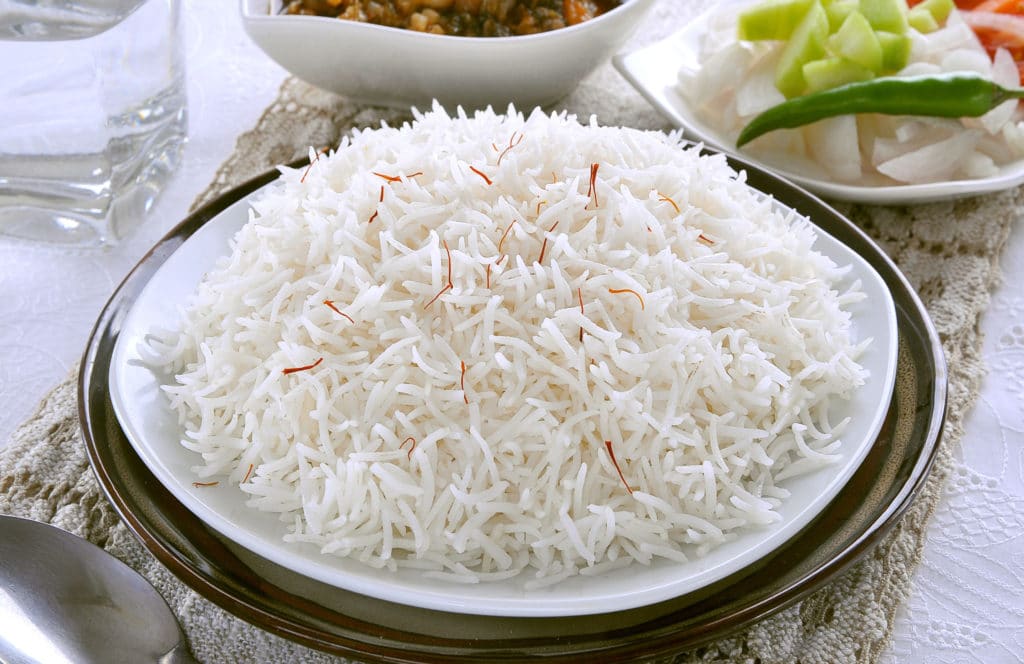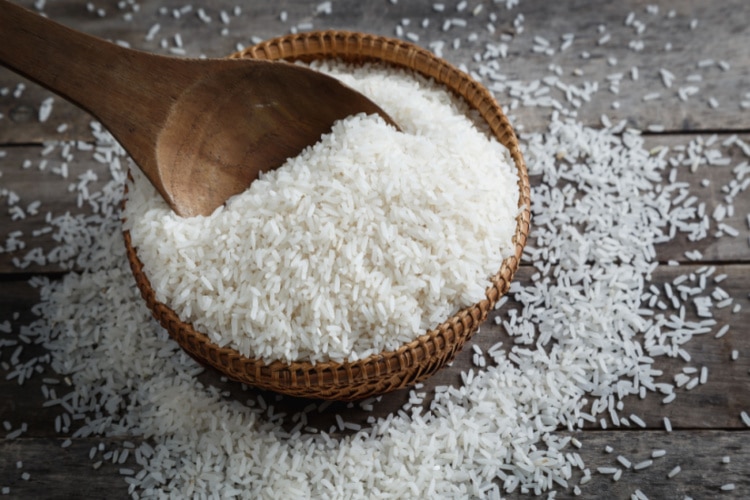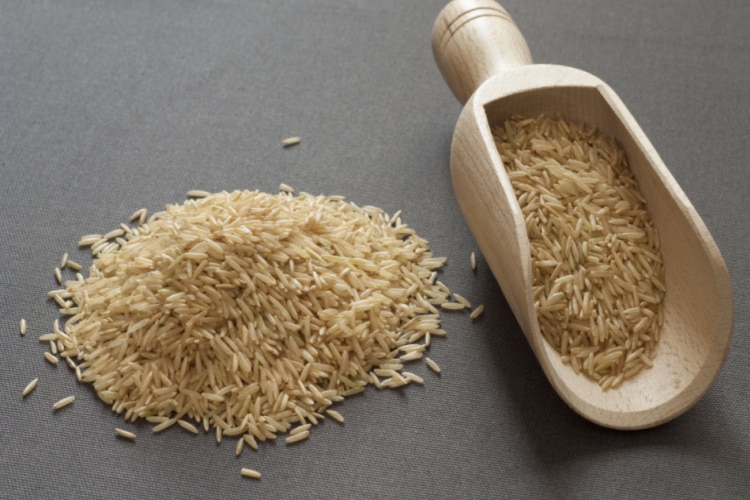Meet basmati and jasmine rice — two types of long-grain rice known for their exquisite scents. Since they are both long-grain and fragrant, people frequently confuse them when placed side by side. But when you get down to the details, they do have fairly distinct characteristics.
Basmati rice is the “Queen of Perfumed Rice”. It has a nutty flavor and flowery scent and is most frequently grown in the Himalayan region of India and Pakistan.
Jasmine rice is as white as the Jasmine flower and is mostly grown in Southeast Asia, particularly in Thailand. It has a sticky and fluffy texture with a more delicate floral flavor.
While they’re fairly similar in looks, basmati is healthier than jasmine for several reasons. Let’s look at them in more detail.
Basmati Rice vs Jasmine Rice: Which Is Healthier?
Basmati rice is a healthier option than jasmine rice for three reasons — more nutrients, less arsenic, and lower glycemic index.

Both types, however, will make tasty and nutritious side dishes, whether alongside beef stew, chicken tortilla soup, or tasty empanadas — and both are comparably healthy thanks to their abundance of fiber and minerals, especially the brown variety. For a more accurate comparison, let’s examine the nutritional value of both kinds.
Jasmine vs Basmati Rice Nutrition Value Comparison
| 1 Cup Cooked Rice (175g)Basmati RiceJasmine Rice | ||
|---|---|---|
| Glycemic Index | 58 | 109 |
| Calories | 191 | 238 |
| Iron | 0% of the DV (Daily Intake) | 2% of the DV (Daily Intake) |
| Fiber | 0.7 g | 1 g |
| Protein | 5 g | 4 g |
| Total Fat | 0.5 g | 1 g |
| Carbohydrates | 39.85 g | 45 g |
| Sodium | 399 mg | 189 mg |
| Calcium | 20 mg | 14 mg |
| Potassium | 59.6 mg | 83 mg |
| Vitamin A | 0 IU | 144 IU |
Looking at the glycemic index is an insightful way to determine which rice is healthier for you. The glycemic index measures how rapidly your body absorbs sugar from carbohydrates. Foods with a low glycemic index are usually thought to be healthier.
Basmati rice has a glycemic index of 58, hence is absorbed more slowly, creating a more gratifying sensation of fullness, whereas jasmine is absorbed quickly, spiking blood sugar levels. In terms of glycemic index, basmati is a better choice.
When comparing the nutritional content of the two types, we can see that jasmine rice has more iron, potassium, and vitamin A than basmati rice. However, when compared to basmati rice, jasmine rice has more calories and carbs.

White basmati rice has less fiber than jasmine rice — unless brown basmati rice is included, but we’ll speak more on that variety later on in this article.
The Healthiest Option: Whole Grain Basmati and Jasmine Rice
Both basmati and jasmine rice have a similar nutritional profile, but the whole grain versions are unquestionably healthier.
Brown basmati and jasmine rice are higher in fiber, proteins, and antioxidants than their whiter counterparts. Their nutritional worth is increased by the fact that they are also higher in vitamins and minerals. Let’s dive deep and go into full detail.
Why Brown Rice Is Healthier Than White Rice
To answer the question of why whole grain rice is healthier, we first have to look at the differences between them, other than the color, of course.
Brown rice is made from entire grains. It contains whole grain components such as fiber bran, nutritive germ, and carbohydrate-rich endosperm. Unfortunately, white rice is deprived of bran and germ.
As a result, white rice has considerably fewer essential nutrients and compounds than brown rice, and lacks fiber. Cooked brown rice has 1.8 gr of fiber, while white rice contains only 0.4 gr.
In addition, when compared to white rice, whole grain rice also has more vitamins, antioxidants, and minerals. The table below shows how much of the recommended dietary intake of nutrients a 3.5 oz (100gr) meal of rice provides.
| 100 gr (3.5 oz) | Brown Rice | White Rice |
|---|---|---|
| Thiamine | 6% | 1% |
| Niacin | 8% | 2% |
| Vitamin B6 | 7% | 5% |
| Manganese | 45% | 24% |
| Magnesium | 11% | 3% |
| Phosphorus | 8% | 4% |
| Iron | 2% | 1% |
| Zinc | 4% | 3% |
By looking at the table we can see that the differences in magnesium and manganese stand out the most. Overall, these differences are minor and ineffective unless you consume rice on a daily basis — the actual difference is in the fiber — the so-called supernutrient that aids digestion and helps us maintain a healthy weight.
Health Benefits of Brown Basmati and Jasmine Rice
According to a recent research, eating whole grains on a daily basis, such as brown basmati and jasmine rice, lowers blood sugar levels and the overall risk of type 2 diabetes.
White rice, on the other hand, has been connected to an increased risk of diabetes. This could be because brown rice has more magnesium and fiber, two nutrients that help regulate blood sugar levels.

There is also research that shows whole grains such as brown rice may also help lower a number of heart disease risk factors. The evaluation shows that those who consume the most whole grains—including brown rice—have a reduced risk of developing heart disease than those who consumed the fewest complete grains.
Last but not least, there are also studies that show a brown rice diet can help people lose weight much more effectively than eating white rice.
Do Brown Basmati and Jasmine Rice Contain Antinutrients?
Yes. All brown rice varieties contain anti-nutrients that may reduce your body’s ability to absorb certain nutrients. In particular, phytic acid or phytate.
Phytic acid is particularly noticeable in whole-grain meals that are consumed raw. The quantity of phytic acid, however, is significantly decreased when that raw meal is cooked.
Additionally, even if we have a raw whole-grain meal, for example, breakfast, the phytic acid may absorb some of the nutrients from that meal in minute amounts, but its anti-nutrient activity won’t have a negative impact on the remainder of your meals.
Are Brown Basmati and Jasmine Rice Higher in Arsenic?
Compared to white rice, brown rice can have higher levels of arsenic. Long-term arsenic consumption is loosely linked to an increased risk of chronic diseases, including cancer, heart disease, and type two diabetes.
But really, it’s always the dose that makes the poison. Hence, this should not be a problem if you eat brown basmati or jasmine rice as a part of a varied diet.
Conclusion
Jasmine and basmati are similar in terms of their nutritional contents, but basmati is the healthier choice. You can go with white or whole grain jasmine and basmati rice.
Whole-grain rice offers more nutritional quality and potential health advantages. Despite the fact that they contain antinutrients and arsenic, their health benefits make these a staple in our kitchens.
That said, there is nothing wrong with eating white rice, and it may definitely be a part of a balanced diet. If you decide to go with white rice, choose white basmati since it has a lower glycemic index.







Thank you
share this information